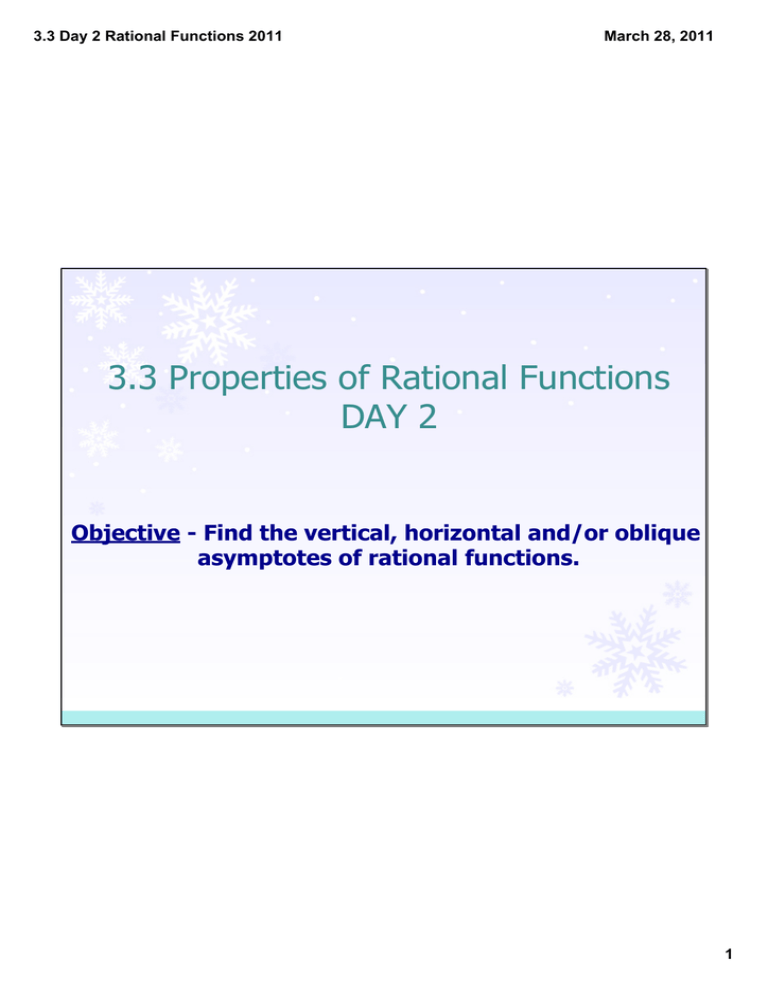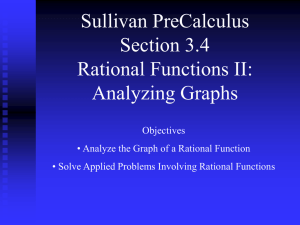3.3 Properties of Rational Functions DAY 2 Objective Find the vertical, horizontal and/or oblique asymptotes of rational functions.
advertisement

3.3 Day 2 Rational Functions 2011 March 28, 2011 3.3 Properties of Rational Functions DAY 2 Objective ­ Find the vertical, horizontal and/or oblique asymptotes of rational functions. 1 3.3 Day 2 Rational Functions 2011 March 28, 2011 Although, the asymptotes of a function are not part of the graph of the function, they provide information about how the graph looks. f(x) = 5 x + 3 + 4 horizontal asymptote vertical asymptote 2 3.3 Day 2 Rational Functions 2011 March 28, 2011 A vertical asymptote, describes a certain behavior of the graph when it is close to some number. The graph of the function will never intersect a vertical asymptote. R(x) = 1 + 1 (x ­ 2)2 vertical asymptote 3 3.3 Day 2 Rational Functions 2011 March 28, 2011 Find the vertical asymptote: (set the denominator equal to zero) x 1. R(x) = 2. F(x) = 3. G(x) = x2 ­ 16 x = ­4 and x = 4 x + 1 x ­ 5 x2 ­ 9 x2 + 4x ­ 21 x = 5 x = ­7 (not x = 3) 4 3.3 Day 2 Rational Functions 2011 March 28, 2011 A horizontal asymptote, describes a certain end behavior. The graph of a function may intersect a horizontal asymptote. R(x) = 1 + 1 (x ­ 2)2 5 3.3 Day 2 Rational Functions 2011 March 28, 2011 An oblique asymptote is neither horizontal nor vertical. An oblique asymptote, describes the end behavior of the graph. The graph of a function may intersect an oblique asymptote. F(x) = x3 x2 + 3x 6 3.3 Day 2 Rational Functions 2011 March 28, 2011 Rules for finding Horizontal & Oblique Asymptotes: Consider rational function: R(x) = p(x) q(x) in which the degree of the numerator is n and the degree of the denominator is m. 1. If n < m, then R is a proper fraction and will have the horizontal asymptote y = 0. x ­ 12 Example: R(x) = 4x2 + x + 1 x 1 ~ = ~ 4x 4x 2 R(x) can never equal 0 7 3.3 Day 2 Rational Functions 2011 2. March 28, 2011 If n > m, then R is improper and long division is used. (a) If n = m, the quotient obtained will be a number a the line y = n is a horizontal asymptote. an bm , and bm 3x + 2 Example: F(x) = x ­ 5 HA: y = 3 (b) If n = m + 1, the quotient obtained is of the form ax + b (a polynomial of degree 1), and the line y = ax + b is an oblique asymptote. 3x4 ­ x2 Example: G(x) = 3 x ­ x2 + 1 Use long division to find OA: y = 3x + 3 (c) If n > m + 1, the quotient obtained is a polynomial of degree 2 or higher and R has neither a horizontal nor an oblique asymptote. Example: H(x) = 2x5 ­ x2 x2 + 1 No horizontal or oblique asymptote. 8 3.3 Day 2 Rational Functions 2011 March 28, 2011 Note: The graph of a rational function has: one horizontal or one oblique asymptote OR no horizontal and no oblique asymptote. 9 3.3 Day 2 Rational Functions 2011 March 28, 2011 Find the horizontal asymptote: 1. F(x) = 2. G(x) = x 2 3x + 1 4x + 3 2x ­ 5 y = 0 y = 2 10 3.3 Day 2 Rational Functions 2011 March 28, 2011 Find the oblique asymptote: 1. F(x) = 3x4 + 5x3 + 4 x3 + 3x y = 3x + 5 11 3.3 Day 2 Rational Functions 2011 March 28, 2011 Homework: page 197 (41 ­ 52) all 12







